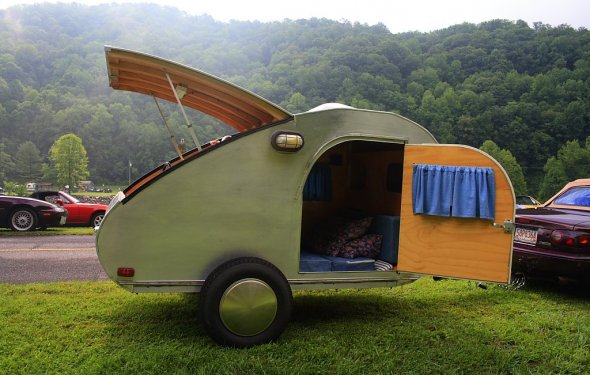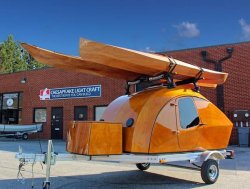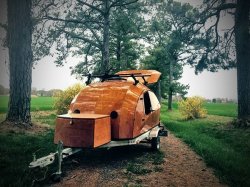build your own caravan kits

 When this wooden boat-building company set its sights on creating a classic teardrop camper with the same materials and techniques it uses when creating beautiful watercraft, the results are nothing short of stunning.
When this wooden boat-building company set its sights on creating a classic teardrop camper with the same materials and techniques it uses when creating beautiful watercraft, the results are nothing short of stunning.
Chesapeake Light Craft (CLC), an Annapolis-based wooden boat-building kit company, has been providing kits, plans, and materials for the amateur and DIY crafter for more than 25 years, but just recently released a completely different kind of product, a build-your-own wooden teardrop camper kit that's sure to turn heads. The company's plans follow the basic shape of a classic teardrop auto trailer, but are built with the same "stitch-and-glue" construction methods used in crafting wooden kayaks and other small boats, and the stylish lines of the finished camper would look right at home on the waterfront.
CLC's CEO and owner, the boatbuilder and designer John C. Harris, says the project grew out of a desire to answer the questions, "What if we take the same boatbuilding materials and techniques we've been refining for 25 years at Chesapeake Light Craft and build a teardrop trailer? And the same sculptural approach that we bring to boat design?"
The camper's plans were created around the footprint of a 60" x 80" (Queen-sized) air mattress, and are intended to provide enough room for two adults (up to 6'6" tall) inside the finished outside dimensions of 5' x 8', which can be mounted "on just about anything with wheels." It's not an RV-killer, by any means, but this little lightweight camper kit could make for a fun alternative for roadtrips and for car-camping with style.
"Think of it as a big step up from a tent in terms of comfort and utility. But it's so compact and light that I could tow it behind my Mini Cooper. Even the smallest 'traditional' RV trailers are going to require at least a mid-sized tow vehicle, and will make a giant dent in your gas mileage." - Harris
 The CLC build-your-own teardrop camper is available as a full kit (minus the trailer), as a 'wood parts only' kit, or just the plans, and the company also offers other components for the build as well, including a storage box and vent kits, and the design can incorporate an (optional) innovative galley in the rear locker area. The design features large doors on both sides of the camper, and a roof hatch for ventilation, and can be fully tricked-out with an onboard electrical system for powering lights, fans, and other electric accessories.
The CLC build-your-own teardrop camper is available as a full kit (minus the trailer), as a 'wood parts only' kit, or just the plans, and the company also offers other components for the build as well, including a storage box and vent kits, and the design can incorporate an (optional) innovative galley in the rear locker area. The design features large doors on both sides of the camper, and a roof hatch for ventilation, and can be fully tricked-out with an onboard electrical system for powering lights, fans, and other electric accessories.
In addition to providing sleeping space for people, this teardrop camper design is also capable of carrying bikes, boats, or other gear on its roof with the addition of a rack, and because this feature was "designed in from the start, " the roof has been engineered to handle a load of up to 150 pounds.
According to the company, the plans were "designed and engineered to fit on anything from a $200 Harbor Freight flatbed to that old boat trailer that's been sitting in your back garden, " but CLC has also partnered with Trailex Sport Utility Trailers to design and build a lightweight aluminum trailer specifically for the Teardrop model, which will be available in the near future.
The finished weight of the CLC Teardrop Camper itself is said to be about 250 pounds once fully kitted out, and depending on the weight of the trailer, the curb weight is estimated to be somewhere around 500 to 600 pounds. The base kit is priced at $1995 (plus shipping), a 'wood parts only' kit runs $1299, and the company intends to soon offer the full-sized patterns and a step-by-step instruction manual for $149. If you're not ready to take the plunge just yet, CLC also offers what it calls 'study plans' for $1, which aren't building plans, but are instead intended to "provide a sense of the construction process." The company also created a Teardrop Builders' Forum for people to share the tips and tricks they've learned while building the campers.